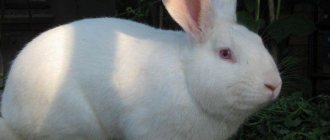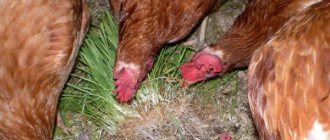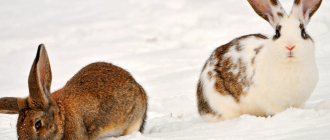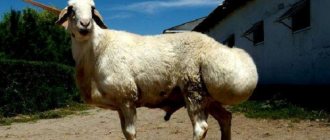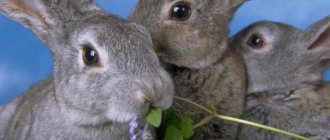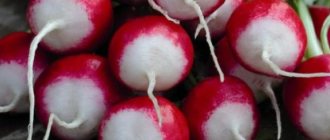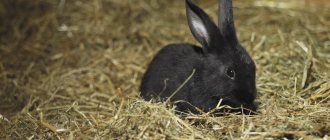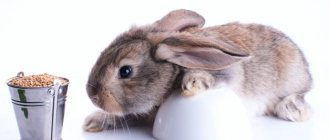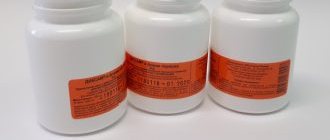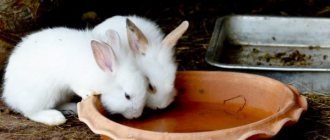What grass can rabbits eat?
To properly feed rabbits, it is necessary to use green grass, leaves and fresh tree shoots throughout the entire season - from early spring to late autumn. Summer is the ideal time to fully feed these animals.
During this period, you can find a sufficient number of different herbs both in forests, meadows and fields, and in your own gardens. This approach also has an economic basis, since it allows you to reduce the amount of grain feed, and therefore products from rabbits will cost much less.
Rabbits should be fed green food from early spring to late autumn. Numerous herbs contain nutritional components and vitamins, and also have medicinal effects. Grass for rabbits has a beneficial effect on the functioning of the digestive system, improves the quality of the coat and accelerates the growth of the animal.
Rodents, which include rabbits, best absorb and digest grain feed. It contains all the components necessary for life and growth:
Beneficial properties of herbs
Grasses appear in early spring and disappear in late autumn with the first frost. The benefits of green feed are quite great:
- They are well digested and quickly absorbed by rabbit stomachs.
- The fiber found in greens (especially those mowed late) has a beneficial effect on the digestive system of domestic herbivores.
- The growth of animals is stimulated.
- Fresh grass is a source of vitamins and nutritional components for rabbits.
- The quality of their wool improves.
Properly selected herbal food strengthens the pet’s immunity and promotes the growth and development of young animals. The consumption of certain types of herbal plants nourishes the animal’s body with various substances and elements necessary for its health, which include:
- vitamins;
- minerals;
- proteins.
Also, decorative rabbits can be given various salads, except lettuce. We also recommend watching a video that tells you how to grow grass for your pet rabbit in winter (in a tray on the windowsill).
Tip: Using green herbs to feed rabbits, you can reduce the amount of grains and feed in the diet by half. This will have a positive impact on the cost of the resulting meat, fluff and fur skins.
The table discusses what herbs can be fed to rabbits without fear for their health, and also notes the nuances of their preparation.
| Herb name | Beneficial features | Secrets of collection and preparation |
| Dandelion officinalis |
| Dandelions are best given in combination with other herbs, but not more than 30% of the total. Exceeding the volume of feeding dandelions to rabbits leads to growth retardation. |
| Siberian hogweed |
| Grows in forest clearings between bushes. It begins to bloom in June-July. Only leaves are used as food for rabbits. |
| Nettle |
| Nettles are given fresh (without flowers) and stored for the winter. When used as green mass, leaves and stems are scalded with boiling water, crushed and added to dry food. Nettle hay is fed to pregnant females in the spring. Nettle leaves collected in late June - early July have a medicinal effect. |
| Coltsfoot |
| Coltsfoot plants begin to produce green mass from mid-May. Harvesting for the winter begins in June. Leaves, flowers and roots are dried. |
| Wheatgrass |
| Leek rhizomes are used as feed, which must be thoroughly washed. Dried rhizomes are stored in a jar for 2-3 years. |
| Plantain |
| Grows on roadsides, in meadows and field boundaries. |
| Sagebrush |
| In the fall, by eating wormwood, rabbits cleanse their bodies of worms. Consumption of a large amount of wormwood (with its share in the feed structure of more than 40%) causes nervous excitement in rabbits. |
What should not be in the diet: prohibited foods
Due to their undeveloped stomach muscles and very long intestines, rabbits must always be provided with sufficient food. Each new portion of food pushes what was previously eaten through the intestines. To avoid stagnation, the rabbit must constantly eat something. However, it is also impossible to overfeed animals, and if there is often food left in the feeders, then the amount of food consumed should be reduced.
Not all grass is good for rabbits.
Rabbits have a very fast metabolism, so they eat a lot. But not every food is healthy. There are some foods that can be extremely dangerous for them. So what should you not feed rabbits? Let's try to figure it out.
Vegetables and fruits
Rabbits love succulent food, which includes vegetables and fruits. But they should not make up more than a third of the total daily diet. An excess of such feed can lead to bloating, disruption of the stomach and intestines, and in some cases, the death of the animal.
Be careful when feeding rabbits dried vegetables in winter. They swell in the stomach, which can lead to intestinal blockage. Do not give boiled, fried or stewed vegetables to rabbits.
Attention! It is strictly forbidden to feed rabbits tomatoes, fresh red beets (with the exception of tops), new potatoes, onions, eggplants and red cabbage.
As for fruits, the choice is small. Rabbits can only be offered dried apples and pears, in small quantities and not often. Moreover, it is better to dry them yourself, after removing the core. Under no circumstances should rabbits be fed any exotic fruits.
You should not give fresh berries to rabbits, they cause fermentation in the intestines.
Plants
The rabbit's diet should contain three types of green food: medicinal herbs, meadow herbs and garden herbs. Freshly cut, wet grass should not be given . Eating wet grass can cause bloating and diarrhea. To avoid unpleasant consequences, it must be well dried and slightly wilted. To do this, fresh grass is left for several hours in a shady, well-ventilated place. If you cut the grass in dry weather, without dew or rain, then you can do without drying it. It is important to know what grass you should not feed your rabbits.
Attention - dangerous herbs!
Eating some herbs in your rabbit's diet can be detrimental to your pets if you don't know which ones are dangerous or poisonous. In addition to edible herbs, quite a large number of dangerous plants grow on lawns, parks, fields and forests. Here is a list of plants that should be avoided:
- Jasmine and poppy are ornamental herbs that cause various ailments.
- Buttercups. Disturbs the functioning of the stomach. Causes diarrhea, vomiting, excessive salivation. The stomach swells when poisoned.
- Euphorbia - it causes animals to vomit.
- Dream-grass. There is simply a full range of negative consequences - paralysis, convulsions, and interruptions in the functioning of the heart. Causes diarrhea and other intestinal disorders.
- Horned cornflower. Negatively affects the ventricles of rabbits. It causes both diarrhea and vomiting. If you eat too much of it, paralysis may occur.
- Datura. In addition to paralysis, it can cause interruptions in the functioning of the heart muscle.
- Veh is poisonous. It also causes anxiety and convulsions in animals, as well as paralysis of the respiratory tract.
- Hemlock. A very poisonous plant, from which the rabbits’ temperature drops, convulsions occur, and complete paralysis can occur.
- Swamp whitewing. It is found mainly in wetlands. When consumed as food, it causes bloating in animals, excessive salivation and general nervousness.
- Indoor plants such as begonia and azalea, amaryllis, etc.
- Great celandine. Weakens the body of animals, reduces appetite, makes them lethargic.
- Marigold. Causes rabbits to urinate frequently, causing colic and vomiting.
- Avran. Inflames the intestinal mucosa.
- Digitalis. It makes the animals’ hearts work faster, resulting in shortness of breath, arrhythmia, and convulsions.
- Frozen or canned green mass.
You should not feed animals greens collected from the sides of large and busy roads - the dust and exhaust gases they contain can lead to digestive disorders. As a last resort, it is necessary to thoroughly rinse such grass.
How to feed rabbits tansy?
This herb attracts eared animals with a pleasant smell, they eat it with pleasure, but excessive consumption of the plant causes intestinal upset and intoxication. Freshly cut greens are especially dangerous. The content of esters in it increases as flowering approaches.
Tansy for rabbit
Rabbits can be given dried tansy, 1 sprig per day. After collection, it is washed with water and left under a canopy for several hours. During drying, the amount of essential oils in the plant cells decreases.
Attention! Rabbits under four months of age and pregnant and lactating females should not be given grass in their diet.
If rabbits are not averse to eating fragrant tansy, you can treat them with healthy food by offering a sprig of dried herbs. This addition to the diet will prevent the development of helminthiasis. Fresh wild rowan is dangerous for long-eared pets, as it contains thujone, a toxic substance.
Basic feeding rules
First, you should understand what a novice rabbit breeder needs to know when supplementing the rabbits’ diet with green food. There are several fairly simple recommendations that are easy to remember and, at the same time, they will significantly increase the chances of raising healthy and strong individuals.
Like all pet food, the grass should be clean, free from rot or mold, and free of any chemicals. The younger the sprouts, the better - they have a large amount of proteins (proteins), but also some fiber.
These rules apply to almost all varieties of herbs and here are the feeding recommendations:
- Only young grass is given for food, since it contains more protein than fiber. And if you feed rabbits with late-harvested herbs, you may encounter problems digesting them.
- Include a variety of plant species in your diet as often as possible. This will have a beneficial effect on the general health of your pets.
- Wet and freshly cut grass, especially with dew, can lead to digestive upset.
- Herbs are harvested by hand and necessarily dried and dried. Plants mowed mechanically oxidize faster and can acquire toxic properties.
- Hay stored for the winter should not have rotten areas or contain mold.
- The feed should not be contaminated with dew, as it causes digestive problems. Animals are not allowed to eat fresh mass - it is first dried and withered.
- If you decide to feed plants after a long break, you should add feed gradually only after concentrated feed. This food is enriched with proteins, and their excess causes indigestion.
- The grass is harvested manually. Greens mowed by mechanical means acquire toxic qualities and oxidize faster.
- Do not collect herbs in areas where pets are walked, near busy highways, or near enterprises that work with hazardous substances. The same applies to grass from outdoor lawns;
- Legumes can cause bloating in rabbits, so they are introduced into the food gradually, preferably mixed with cereals.
Did you know? In Australia, wild rabbits are considered the worst enemies of the local population and agricultural enterprises. The country has introduced a ban on the breeding of these seemingly cute animals at the state level. Each violator faces a fine of 30 thousand US dollars. As it turned out, the mammals angered the aborigines with their rapid life activity, the annual losses from which are estimated at around 600 million US dollars.
What can you feed rabbits?
The rabbit's digestive system has a special structure. The back teeth are longer than the front teeth. The size of the intestine is several times larger than the body of a rabbit. Rabbits need food that can be chewed, tree branches and tops. Depending on the state of the rodents’ intestines, immunity will be formed. Green grass has the best effect on him.
Rabbits can eat almost anything. The menu requires the presence of juicy, coarse, green, concentrated, vitamin-mineral complex products, as well as leftovers from table waste.
It is very important to keep rabbits hydrated. The liquid must be clean; it is better to use well or spring water. In winter, clean snow can be used for drinking.
Tip: Rabbits need to be watered at the same morning and evening hours, before they eat. In the warm season, rodents are offered plenty of drink at lunchtime.
When eating juicy food, the rabbit may drink less water than usual. When eating dry food, on the contrary, you will need more liquid than usual.
Tip: A pregnant rabbit should drink about a liter of water during the day, nursing at least two liters.
In order for rabbits to gain weight, especially if the fattening period occurs in the winter, they should be fed according to an increased concentration scheme; concentrates and roughage are given in larger quantities than in other periods. Additionally, the animals are fed silage and root crops. Different age and target groups eat according to their own standards.
Fattening rabbits require: 150 g of hay, 500 g of root vegetables, concentrates will be 80 g per day. Resting males and females need: 150 g of roughage and root vegetables, as well as 40 g of concentrated food.
During the mating period, males need: 150 g of roughage, 200 g of root vegetables, and 55 g of the daily ration will be concentrates. Pregnant rabbits need: 180 g of roughage, 200 vegetables, concentrates are 60 g. Young pregnant rabbits need to be given: 250 g of roughage, concentrates are 70 g, and vegetables are 300.
In the first 15 days after giving birth, nursing rabbits need: 200 g of coarse food, 400 g of root vegetables and 90 g of concentrates; for lactating females in the second half of the month together with rabbits: 12 g of coarse products, 5 root vegetables and 7 concentrates.
One-month and two-month-old young animals need: 50 g of roughage, 150 g of root vegetables, and concentrates are needed in the amount of 35 g. Three and four month old rabbits should be given: 100 g of roughage, 300 g of vegetables and 55 g of concentrate. Five and seven month olds: 150 g of roughage, 350 g of root vegetables and 75 g of concentrate.
Advice: It is allowed to feed rabbits with bread, but give it only as additional food; this will only make the rabbit meat tastier and the animal’s skin more beautiful. The exception is decorative breeds.
The acceptable norm is 10 g of loaf per kilogram of rabbit weight (daily dosage). They give black and white types of bread. A fresh product can clog the intestines, so it is preferable to feed your pets with crackers, either specially small dried ones, or a large dry piece is broken and poured into a feeder with other food. The main thing is that there is no mold. Little rabbits should not be given baked goods at all.
Compliance with the feeding regime for rabbits is mandatory. When food is distributed to pets in a timely manner, their bodies produce gastric juice, with the help of which food is absorbed and processed. What causes the growth and development of animals to occur at a rapid pace. Long-eared rodents eat frequently (about 80 times a day), but the portions are small. For example, a female rabbit during the lactation period and baby rabbits up to 3 months should be fed four times during the day; fresh full portions of food should be given to the adult generation and young fledged individuals 2 or 3 times.
Summer feeding of rabbits three times a day includes: morning (about 6 o'clock), when a third of the daily ration of grass is given, at 3 o'clock in the afternoon a third of green food is given, in the evening (about seven o'clock) you need to give half of the concentrate, a third of greens and branches.
Summer four-time feeding includes: at 6.00 rabbits are given a sixth of grass and a third of concentrates, at 11 o’clock a sixth of green food and a third of concentrates, half of the amount of grass should be given at about 16:00 in the afternoon and in the evening (about 19:00) a third part concentrated food, a sixth part green and branches.
Green food on your site
Experienced owners know what kind of grass can be fed to rabbits, and while weeding the beds, they set aside removed weeds, as well as thinned vegetable crops, and the remains of pruned branches of fruit trees. It can be:
- Nutritious legumes.
- Oats, which can actually be sown twice per season. To do this, the second batch must be planted immediately after the first mowing.
- Borage, which is very useful for those with long ears, requires deep planting.
- Green peas are used for food in the dried form of stems and pods.
Clover grows well and quickly after planting. Another plant for a summer cottage is considered cultivated alfalfa. Rabbits simply adore it, and it is easy to grow, since the crop can withstand any climatic conditions.
Type of food
You should not feed your pet one specific type of grass for a long time. It is best to form a kind of herbal complex, collected from various species.
By using fresh grass feed, rabbit breeders must understand their benefits, and they are quite obvious:
- A minimum amount of money and time is spent on harvesting herbs.
- Savings on the purchase of dry food and grain crops due to the use of green mass.
- The stems and leaves of legumes contain many amino acids and proteins. And they contribute to the rapid growth and gain of live weight of animals.
In autumn and winter, there is a shortage of green grass. Therefore, many inexperienced rabbit breeders may immediately have a question: how to feed their pets grass? At this time, succulent food should be introduced into the diet, namely vegetables and silage (special canned food for rabbits). This type of food is easy to digest, it is quickly absorbed, and has a positive effect on digestive processes, as well as on lactation.
Closer to spring, hay reserves usually come to an end; for this period it is necessary to prepare branch feed. To do this, at the beginning of summer, young branches are cut from various deciduous trees, tied into brooms and dried in a ventilated room.
You can include the following succulent foods in your eared menu:
- red and yellow carrots. This vegetable is an essential source of carotene, vitamins B and C, all of these components are necessary for the body of rabbits in the winter;
- fodder cabbage. The vegetable contains a high level of vitamin K, protein, as well as mineral elements - calcium, sulfur, phosphorus, iron;
- You can give beets fresh or dried. Sugar beets are well digestible. But this vegetable crop should be given in limited quantities;
- Sometimes rabbits can be fed potatoes. But since it contains a high level of starch, it is recommended to boil the vegetable;
- Be sure to additionally feed the animals with pumpkin, watermelon, and zucchini.
Rabbits are very fond of raspberry and linden, alder and rowan branches. Plants such as apricot, buckthorn, elderberry and bird cherry cannot be used. The branches of these trees contain toxic substances and can harm your pet.
You can give your rabbit branches from the following trees:
- Maple
- Apple tree
- Rowan
- Ash
- Mulberry
- Grape
- Acacia
- Raspberries
Sometimes you can feed branches:
- Duba
- Birches
- Alders
- And you
- Coniferous trees
In the spring-summer season, when forbs are rampant, green matter in the rabbits' diet half replaces feed and cereals.
